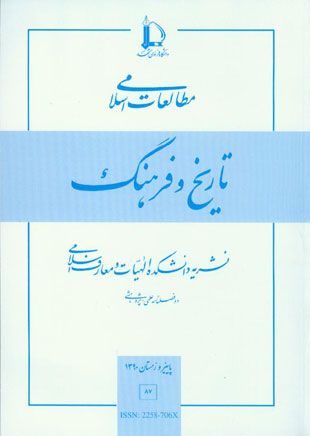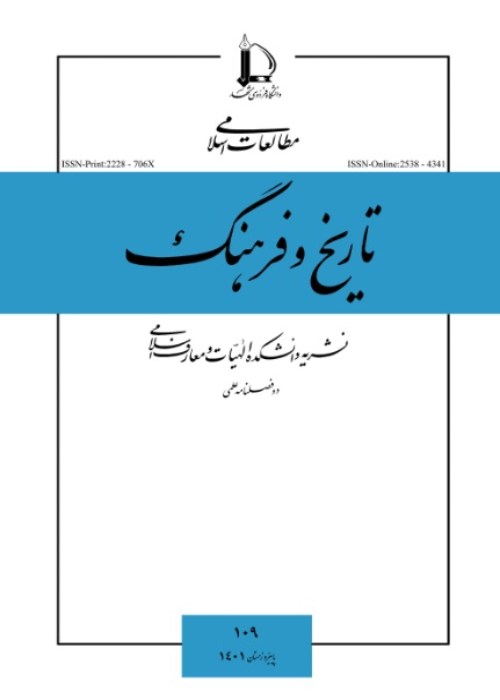فهرست مطالب

نشریه تاریخ و فرهنگ
سال چهل و سوم شماره 2 (پیاپی 87، پاییز و زمستان 1390)
- 126 صفحه، بهای روی جلد: 8,000ريال
- تاریخ انتشار: 1391/10/20
- تعداد عناوین: 6
-
-
دارالفنون رضوی / ایده ای برای مقابله با فعالیت های هیئت تبشیری پرس بی تریان در مشهدصفحه 9مسیونرهای آمریکایی از اواخر دوره قاجار در مشهد به فعالیت پرداختند و هیئت تبشیری پرس بی تریان در مشهد ابتدا مریضخانه ای ایجاد و از سال 1301 ش/1342 ق/1923 م با خرید زمینی وسیع در محله پاچنار طرح بزرگی را برای ساخت مدرسه و کلیسا پی ریزی کرد. این اقدام مسیونرهای آمریکایی واکنش های مختلفی از سوی علما، تجار و سایر مردم داشت که خواستار توقف فعالیت آنان شدند.
یکی از واکنش ها از سوی دکتر امیر اعلم رئیس حفظ الصحه خراسان بود که برای مقابله با تبلیغات مذهبی و فرهنگی مسیونرهای آمریکایی پیشنهاد تاسیس دارالفنون رضوی را مطرح کرد. وی در این زمینه مکاتباتی با روحانیون، نمایندگان مجلس، رئیس الوزراء و نیابت تولیت آستان قدس داشت و توانست همکاری آنان را جلب کند. در این مقاله تلاش می شود علل و زمینه شکل گیری ایده دارالفنون رضوی، افکار و اندیشه های دکتر امیر اعلم درباره آن، ابعاد، ویژگی ها و اثرات این دارالفنون و سرانجام، علل ناکامی این ایده مورد بررسی قرار گیرد.
کلیدواژگان: دارالفنون رضوی، پرس بی تریان، مشهد، امیراعلم -
صفحه 27نیشابور در سده های 3 6 ق رشد علمی چشمگیری یافت که با فراز و فرودهایی همراه بود. این پیشرفت علمی با شرایط مطلوب اقتصادی پیوند داشت. یکی از مصادیق وضع اقتصادی مطلوب در نیشابور در معیشت عالمان نمودار می شد و از این رو، پیشرفت علمی عالمان تا حدودی به معیشت آنان وابسته بود. در میان عالمان نیشابور، رشد محدثان بیش از دیگر عالمان به سطح معیشت آنان وابسته بود؛ زیرا این پیشرفت تا حدود بسیاری از طریق رحله به دست می آمد و رحله به ویژه رحله گسترده و اقامت طولانی برای تحصیل و سماع حدیث در شهرهای دیگر هزینه نسبتا گزافی برای دانشجویان حدیث در بر داشت. بیش تر محدثان برجسته نیشابور در طول این سده ها از معیشت نسبتا مطلوبی برخوردار بودند و به طبقه ثروتمند یا نسبتا برخوردار تعلق داشتند.
کلیدواژگان: رحله، محدثان، نیشابور -
صفحه 51شواهد النبوه عبدالرحمن جامی (د. 898 ق) از جمله کتاب های نگارش یافته توسط یکی از دانشمندان اهل سنت است که با ذوقی صوفیانه نگاشته شده است. جامی در این کتاب به زندگانی پیامبر (ص)، دوازده امام (ع) و اصحاب، با رویکرد دلائل نگارانه پرداخته و درباره امامان (ع)، همان گزارش هایی را ارائه کرده که بی کم و کاست در منابع شیعی یافت می شود. رویکرد این کتاب تقریبی است و به گستردگی به نقل معجزات، کرامات و خوارق عادات ائمه پرداخته است. روند یاد کردن از مناقب ائمه که از قرن چهارم در کتاب های نخستین صوفیان، آغاز شده بود، در قرن نهم با تدوین کتاب هایی همچون شواهدالنبوه کامل گشت، به گونه ای که یکسانی و مشابهت اطلاعات در زمینه زندگانی ائمه در دو گروه منابع شیعی و سنی مشاهده می شود. این مقاله با بررسی بخش زندگانی و کرامات دوازده امام (ع) در شواهدالنبوه و مقایسه آن با مطالب مندرج در کشف الغمه علی بن عیسی اربلی (د. 692)، دانشمند شیعی قرن هفتم، در صدد نشان دادن، همخوانی و یکسانی منابع اهل سنت و شیعیان در خصوص گزارش زندگانی ائمه برآمده است.
کلیدواژگان: جامی، شواهد النبوه، دوازده امام، دلائل نگاری -
صفحه 69در مورد قدمت صنعت شیشه سازی در شام اختلاف نظر وجود دارد. بعضی آن را مربوط به دوره پس از اسلام و با الهام از صنعتگران رومی که برای ساخت بناها در عصر اموی استخدام شده بودند، می دانند، اما گروهی دیگر معتقدند پیشینه این صنعت به قرن ها قبل از ورود اسلام به شام بر می گردد و در عصر اسلامی با حمایت خلفا و امیران این صنعت احیا شد وگسترش یافت و در بناهایی که در عصر اموی ودیگر دولت های اسلامی در شام ساخته شد مورد توجه قرار گرفت.
صنعت شیشه سازی در عصر فاطمیان و زنگیان به اوج خود رسید. به طوریکه شهرهای دمشق، حلب، صور و رقه به عنوان مراکز ساخت شیشه مطرح بودند. در این عصر مصنوعات شیشه ای از نظر تنوع تزیینات و میناکاری و نقاشی با طلا بر روی آن رشد بی نظیری کرد. از نظر تنوع محصولات نیز انواع ظروف، گلدان، مجسمه، ظروف ادویه وعطردان و حتی قطعات شطرنج را شامل می شد.
در عصر فاطمی شیشه هایی با کیفیت خوب، شفاف، سفید و بدون خط تولید می شد که مورد استقبال طبقه مرفه و تجار قرار گرفت و به عنوان یکی از محصولات مهم شام به نقاط مختلف جهان از شرق اسلامی گرفته تا اروپای غربی صادر می شد.
کلیدواژگان: شیشه، تزئین شیشه، شام -
صفحه 89رویکرد سیاسی شیخ زاهد گیلانی، زمینه های تفکر سیاسی و نزدیکی به قدرت مداران زمانه را در شیخ صفی الدین اردبیلی پرورش داد. شیخ صفی الدین علاوه بر کسب آداب صوفیانه و عرفانی، راهبردهای سیاسی برای توسعه طریقتش را از محضر استاد فرا گرفت. این رویکردها به یک جنبش سیاسی در طریقت صفوی تبدیل شد و در نهایت موسس یکی از سلسله های بزرگ در تاریخ ایران گردید.
کلیدواژگان: تصوف، شیخ زاهد، شیخ صفی -
صفحه 107در دوره سلطنت شاه اسماعیل یکم، مقام وکیل نفس نفیس همایون به عنوان نایب السلطنه انجام وظیفه می کرد. شاه اسماعیل پس از شش سال که این عنوان در اختیار یکی از اهل اختصاص که ترک قزلباش بود قرار داشت، آن را به یک فرد غیر ترک واگذار کرد و تا پایان عمر به همین رویه ادامه داد. خاستگاه اجتماعی مقام وکیل در این دوره، عملکرد سیاسی و اجتماعی وکلا، چالش ها و مشکلات فراروی آنان همراه با تبیین وجوه اشتراک و اختلاف وکلای این دوره، اهداف اصلی این مقاله را تشکیل می دهد.
کلیدواژگان: صفویه، اسماعیل یکم، قزلباش، وکیل، صدر، تاجیک
-
Page 9American missionaries were active in Mashhad since Qajar period and the Presbyterian mission first established a hospital in Mashhad and set up a great project for construction of a school and church by purchasing a large piece of land in Pāchinār neighborhood since 1301 sh/1923. This enterprise by the American missioners elicited various reactions from the scholars, businessmen and others to stop their activities.One of the reactions was by Dr. Amīr A‘lam, the chief of Khurāsān Sanitorium (Ḥifẓ al-Ṣiḥḥa), who proposed to establish Raḍawī Dār al-Funūn to confront the American missionaries’ religious and cultural propaganda. He had some correspondence with the clerics, members of parliament, chief of ministers, and the deputy custodian of Āstān Quds and was able to attract their cooperation. It is attempted in this article to examine the reasons and the grounds for the inception of the idea of Raḍawī Dār al-Funūn, Dr. Amīr A‘lam’s ideas about it, the features and impacts of this educational institution, and finally, the causes for its failure.Keywords: Raḍawī Dār al Funūn, Presbyterian, Mashhad, Amīr Alam
-
Page 27Nayshābūr achieved considerable scholarly growth in the 3rd-6th/9th-12th centuries that was coupled with some ups and downs. This scholarly and academic growth was associated with desirable economic conditions. One of the instances of desirable economic conditions in Nayshābūr was manifested in the scholars’ livelihood, and therefore, the scholars’ academic progress was to some extent dependent upon their livelihood. Among the scholars of Nayshābūr, the progress of ḥadīth scholars was more dependent upon their level of livelihood in comparison to other scholars, since this progress was mostly achieved through the journeys (riḥla), which involved relatively huge expenses for the students of ḥadīth, particularly in their widespread and long journeys for study and listening to the traditionists (muḥaddiths) in other cities. Most of the eminent traditionists of Nayshābūr enjoyed relatively desirable living conditions during these centuries and belonged to the wealthy or relatively well-to-do class.Keywords: journey, traditionists, Nayshābūr
-
Page 51Shawāhid al-Nabuwwa of ‘Abd al-Raḥmān Jāmī (d. 898/1492) is among the books written by one of the Sunnī scholars who has authored it with a Sufi taste. In this book, Jāmī has addressed the life of the Prophet (S.A.W.), the twelve Imams (A.S.), and the companions (ṣaḥāba) with a miracle-oriented approach and has presented precisely the same reports about the Imams (A.S.) that are found in Shī‘ī sources. The approach of this book is “approximate” and has widely narrated the Imams’ miraculous acts and supernatural feats. The trend of the Imams’ hagiography, started since fourth/tenth century in early Sufi books, was perfected in ninth/fifteenth century by the compilation of such books as Shawāhid al-Nabuwwa, in a way that a similarity is noticed in the data concerning the life story of the Imams in both Sunnī and Shī‘ī sources. Examining the part of life story and miraculous acts of the twelve Imams (A.S.) in Shawāhid al -Nabuwwa and comparing it with the contents of Kashf al-Ghumma of ‘Alī b. ‘Īsā Irbalī (d. 692/1106), the seventh/thirteenth century Shī‘a scholar, the present article is intended to show the conformity and similarity of the Sunnī and Shī‘ī sources concerning their reports on the life story of the Imams (A.S.).Keywords: Jāmī Shawāhid al Nabuwwa, twelve Imams, miracle, orientation
-
Page 69There is disagreement about the antiquity of glassmaking industry in Shām. Some trace it back to the post-Islamic era and regard it as being inspired by the Roman artisans who had been employed for constructing buildings in the Umayyad reign. Others, however, believe that this industry is traced back to centuries before Islam entered Shām and was restored and developed by the support of the Caliphs and Amīrs during the Islamic era in the buildings constructed in the reign of the Umayyad and other Islamic governments in Shām.Glassmaking industry reached its peak during the Fatimid and Zangid reigns so much that such cities as Damascus, Aleppo, Tyrus, and Raqqa were known as the centers for glassmaking. In this era, glassware artifacts were highly flourished in terms of variety in decorating, enameling, and gilding on glass. Various glass products also included different kinds of utensils, vases, statues, spice and perfume containers, and even the chess pieces.In the Fatimid period, clear and white glassware with fine quality and without line was produced and was welcomed by the wealthy class and the merchants. As one of the significant products of Shām, It was also exported to all parts of the world, from Islamic East to the Western Europe.Keywords: glass, glass decoration, Shām
-
Page 89The political approach of Shaykh Zāhid Gīlānī paved the way for Shaykh Ṣafī al-Dīn Ardabīlī’s political thinking and his closeness to the power-holders of the time. In addition to acquiring the rules and manners of Sufism, Shaykh Ṣafī al-Dīn learned from his master the political approaches for expanding his Sufi order, as well. These approaches turned into a political movement in the Safavid order and eventually laid the foundation for one of the great orders in the history of Iran.Keywords: Sufism, Shaykh Zāhid, Shaykh Ṣafī
-
Page 107In the reign of Shāh Ismā‘īl I, the position-holder Wakīl-i Nafs-i Nafīs-i Humāyūn would serve as the regent (nāyib al-salṭana). After six months that this position was held by one of the elites who was a Qizilbash Turk, Shāh Ismā‘īl handed it over to a non-Turk and continued the same procedure to the end of his life. The present article is mainly intended to study the social origin of the wakīl (representative, deputy) position in this period, the socio-political function of the councilors, the challenges and difficulties faced by them, and explanation of the similarities and differences among the councilors of this era,Keywords: Safavids, Ismāīl I, Qizilbash Turk, councilor, chief position (ṣadr), Tajik


